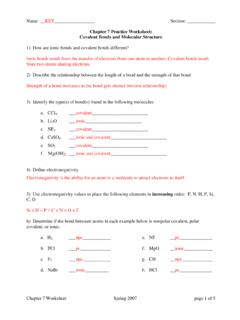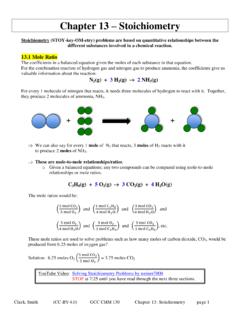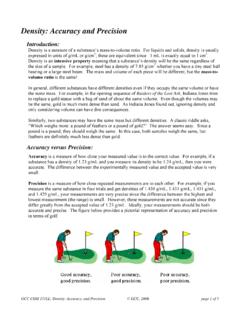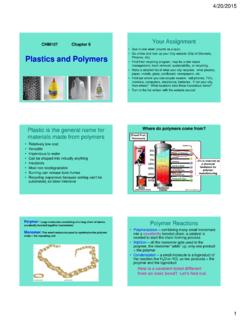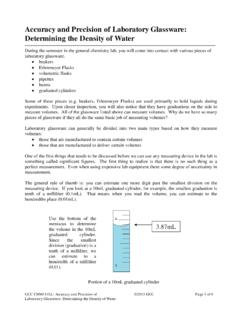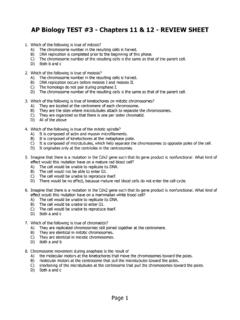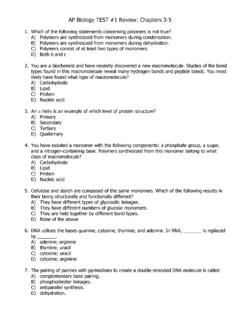Transcription of Marine Biology: Study Guide - web.gccaz.edu
1 BIO145: Marine biology 1 Study Guide Marine biology : Study Guide Welcome to Marine biology ! biology is the scientific Study of life and living things. Marine biology focuses on life in and around seas and oceans. As a non-majors course, Marine biology will emphasize the philosophy of science as we Study ocean life. We will also survey the many levels at which life can be studied, from molecular building blocks ( proteins and DNA) to whole organisms and the ecosystems in which they live. We will focus on four topics: 1. the ocean environment (geology, chemistry, winds and waves) 2. the groups of organisms found in the oceans, primarily multicellular forms (examples: kelp, mollusks, crustaceans, fish and whales) 3.
2 The adaptations of these organisms and how these adaptations fit them for their role (niche) in the environment (habitat) 4. the ecology of these organisms: their interactions with the living and non-living aspects of their environment; with particular focus on intertidal, kelp and coral-reef ecosystems Purpose: This Study Guide provides a checklist of terms, concepts and topics in BIO145. Although arranged by chapters from your text, topics may be presented at various times in lecture, lab, or both. This Guide is not exhaustive. It should be used with your lecture & laboratory notes, as well as your text. Each chapter includes a review with practice questions. Be prepared to answer these questions on an exam.
3 You should also make use of the online tools available with your textbook and the various links on my web site: ~ PART I. PRINCIPLES OF Marine SCIENCE, ECOLOGY and SPECIAL REPORT: Our Changing Planet. Chapters 1 & 10 and pages 231-243 chapter 1. The Science of Marine biology This chapter introduces the topic of Marine biology , a historical summary of human involvement with the oceans: economic, travel, aesthetic, discovery and scientific. It includes a review of scientific Study and innovations, with a review of many state of the art technologies. Finally, it provides an introduction to the general principles and methods of science. Be able to describe the three general reasons that humans are interested in the sea: aesthetic, commercial, scientific, and provide examples.
4 BIO145: Marine biology 2 Study Guide You should be able to identify a few of the key cultures, individuals and expeditions in the history of Marine science: Phoenicians Aristotle Cook Voyage of the Beagle Arabs Erikson Darwin The Wilkes Expedition Micronesians Columbus Cousteau The Challenger Expedition Polynesians Magellan Alvin LEO/COOL Be able to define and describe modern technology as used by Marine scientists: sonar, scuba, submersibles (submarines, ROV s & AUV s) and satellites. Who is Alvin? Be familiar with the general approaches to the scientific method, particularly: observation hypothesis formation experimental design hypothesis testing significance of results alternative hypotheses You also need to be able to define, discuss, and use the following terms: induction deduction hypothetico-deductive method variables theory controlled experiment Why must hypotheses be written in a form that is falsifiable (testable)?
5 Why is it important for scientists to try to disprove hypotheses? Can any hypothesis ever be proven to scientists? To practice the scientific method, start with an observation of the Marine world. This observation may come from your readings in the text, lecture material, library source, a TV program, or a day at the beach. Next, formulate a hypothesis that provides a cause and effect explanation for the observation. The hypothesis should be formed as a statement (not a question) so that it can be falsified (disproved). How could you test this hypothesis? Think of an experiment that would manipulate the independent variable and potentially affect the dependent variable. What factors should you control?
6 If the results from this experiment were similar to those you predicted, what could you conclude? If the results did not support your hypothesis, what would you conclude? What might you do next? BIO145: Marine biology 3 Study Guide chapter 10 An Introduction to Ecology Ecology is the scientific Study of the interactions between organisms and their environment that determine the distribution and abundance of organisms. We will examine Marine biology primarily from an ecological perspective, therefore we will cover this topic early and return to it throughout the course. Ecology can be studied at many levels, and at each new level of complexity emerge new properties. We will concentrate on organismal ecology, population ecology, community ecology, and ecosystem ecology, but will refer to other aspects of ecology and behavior.
7 Be able to describe each type of ecology, and the patterns & processes related to each: organismal population community ecosystem What is a habitat? What is an organism s niche? What is an n-dimensional niche? An organism s environment can be broadly described as all things encountered by that organism. Environmental factors that affect an organism s distribution can be classified as either abiotic (non-living) or biotic (living) factors. Be able to provide several examples of each. How does variation in these factors affect organismal distribution? Population ecology is concerned with factors that effect population size and related characteristics. Be able to describe how each of the four factors below affect population size: births deaths immigration emigration Populations may be regulated by either density-dependent factors, density-independent factors, or both.
8 Be able to define both of these terms and provide examples of each ( intraspecific competition). Community ecology is concerned with the number and diversity of organisms found in a given community and the interspecific interactions responsible for these patterns. Be able to describe each type of interaction; who benefits and who loses? competition predation parasitism mutualism commensalism BIO145: Marine biology 4 Study Guide Models of competition led to the competitive exclusion principle. Explain the foundation for this idea. What is resource partitioning? Be able to illustrate with an example. Describe the difference between a fundamental niche and a realized niche. What factor(s) account for this difference?
9 Be able to illustrate with an example of Chthamalus and Balanus or Semibalanus (see also fig. ). Be able to compare and contrast: predator, parasite, parasitoid & herbivore. What is the evolutionary arms race between predators and their prey? What is symbiosis? What is the difference between commensalism and mutualism? Be able to give examples of both from class or films. What is a keystone predator? Be able to define this term and illustrate the concept with examples from your text and lecture. How does a keystone species differ from a dominant species? Describe the relationship between diversity and disturbance. What level of disturbance should lead to greater diversity? (Intermediate Disturbance Hypothesis) What is an opportunistic species?
10 How does this compare to species with a competitive strategy? What factors allow both to coexist in the same community? What is an ecosystem? Two main questions are the focus of ecosystem ecology: the flow of energy and the cycling of nutrients. Be able to describe these terms. Be able to define and describe: autotroph heterotroph producer consumer trophic structure trophic level food chain food web Be familiar with the simplified food chains & food web described in text & lecture. BIO145: Marine biology 5 Study Guide What is primary productivity? Be able to describe a light-dark bottle experiment as a method to determine primary productivity. How well is energy converted between trophic levels?
